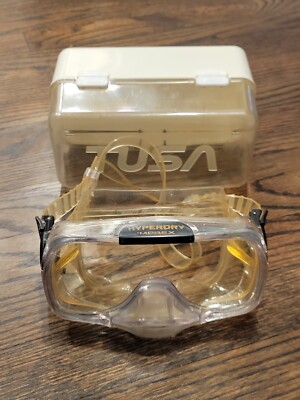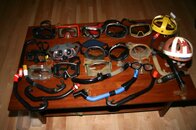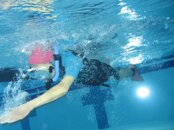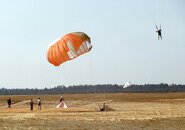You mention that water in your wife’s nose is a big problem (or I read it in another post). May I suggest a fairly large volume mask with a good purge valve in front as a counter to that problem.
Also, I think I related that I was diving for three years before ever receiving actual instruction. I was certified LA County in 1963. I really don’t feel that scuba diving is that hazardous, especially if the depth is limited to say 30-40 feet. I was diving rivers and lakes at the time, and shallow.
Take a look at my mask collection below, and note that the larger, tri-window mask by Scubapro in silicone, may be the best for this situation. The mask on the lower left, which is a TUSA “Hyperdry” Imprex, is my wife’s mask and she really likes it.

Finally, I have experience in a number of fear-inducing activities, such as parachute jumping in the U.S. Air Force. My experience was that, even after two weeks of training in parachuting and parachute landing falls (PLFs), it wasn’t the first jump that was producing the most anxiety; it was the third. The first one was almost automatic, the second I started thinking about it after the jump, and the third parachute jump produced the most anxiety before the jump. Then, I survived that third jump, and I was good from then on, and could focus more on jump techniques, how I exited the plane, and the PLF.
Diving may be the same for some as parachuting; it takes some experiences (plural) to become more comfortable with scuba. And, it may not be the first scuba experience that produces the most anxiety. But over time, with more experiences, it becomes routine and does not produce that high level of anxiety.
SeaRat
Also, I think I related that I was diving for three years before ever receiving actual instruction. I was certified LA County in 1963. I really don’t feel that scuba diving is that hazardous, especially if the depth is limited to say 30-40 feet. I was diving rivers and lakes at the time, and shallow.
Take a look at my mask collection below, and note that the larger, tri-window mask by Scubapro in silicone, may be the best for this situation. The mask on the lower left, which is a TUSA “Hyperdry” Imprex, is my wife’s mask and she really likes it.

Tusa Imprex 3D Hyperdry Mask and Case ☆ See Pictures ☆ Fast Shipping ☆ | eBay
Tusa Imprex 3D Hyperdry Mask and Case ☆ See Pictures ☆ Fast Shipping ☆
www.ebay.com
Finally, I have experience in a number of fear-inducing activities, such as parachute jumping in the U.S. Air Force. My experience was that, even after two weeks of training in parachuting and parachute landing falls (PLFs), it wasn’t the first jump that was producing the most anxiety; it was the third. The first one was almost automatic, the second I started thinking about it after the jump, and the third parachute jump produced the most anxiety before the jump. Then, I survived that third jump, and I was good from then on, and could focus more on jump techniques, how I exited the plane, and the PLF.
Diving may be the same for some as parachuting; it takes some experiences (plural) to become more comfortable with scuba. And, it may not be the first scuba experience that produces the most anxiety. But over time, with more experiences, it becomes routine and does not produce that high level of anxiety.
SeaRat






